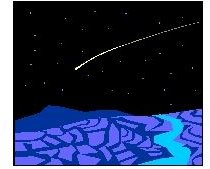Photographing Meteors - Capturing the Best Pictures of Meteor Showers
Photographing Meteors
The first thing to understand when attempting to take a digital picture of a meteor is that no matter what it seems like to a fully adjusted naked eye, they are not that bright. That means that in order to have success photographing meteors, pointing the camera up at the sky and pressing the shutter button is out. Meteor photography requires a tripod and a lot of luck too.
Night sky photography is often accomplished by placing a camera on a tripod and using very long exposures. However, this can be a problem with today’s advanced digital cameras. One problem is that exposures of over 15 minutes in length can begin to show star trails. Star trails are caused by the movement of the stars in the sky around Polaris.
The second problem is that digital camera sensors are more sensitive to background light than traditional film cameras. A thirty minute exposure will cause the background to be so bright on a digital camera that most meteors would not show up against, even in an area with very dark skies. Likewise, over the course of several minutes, each star’s light will build up on the sensor causing very faint stars to have equal brightness on the digital image as a much brighter meteor will create over a few short seconds.
Effective meteor photography does take longer exposures, but times less than 10 minutes work better for digital cameras. To determine the best exposure length for the particular night of shooting, take several different length exposures using the best ISO setting your camera can handle, and view them on a laptop. Pay particular attention to the contrast of the brightest stars against the night sky, and the visibility of the faintest stars that you want to show up in your images. Use the time that generates the image you desire to have for your meteor background.
Since it is impossible to predict exactly when and where a meteor will appear, meteor photography has a large element of chance. To maximize the possibility of a meteor showing up in your photograph, choose a location far away from city lights. As mentioned before, digital cameras are particularly sensitive to background light and miles of nearby streetlights will make shooting difficult if not impossible.
Meteor Photography Techniques
The best time to attempt to photograph meteors during a major meteor shower. The more meteors there are, the better chance that one will fall through your camera’s field of view. Aim your camera so that its field of view captures an area about 50 degrees from the horizon and about 35 degrees from the meteor shower’s source, called “radiant.” Meteors closer to the radiant tend to be very short making their trails hard to see in the photo. Further away, and they can be too long passing completely through the field of view (and leading others to wonder if it was really an airplane).
While the shorter exposure required by digital cameras makes it less likely that a meteor will appear during any given exposure, digital does have the advantage of being able to take numerous shots in a row without using up expensive film. For maximum productivity, hook your camera to your laptop (be sure to turn off the screen while you are shooting). Thousands of exposures can be stored on most hard drives, or if you prefer, attach an external drive. Use electrical tape to mask over any LEDs or other light sources.
Program your laptop to automatically take continuous exposures of the appropriate length. This eliminates the need for the photographer to pay close attention to the shutter closing before manually resetting. These few seconds may be the difference between capturing a wily meteor and not.
Finally, with hundreds or thousands of images to sort through, you will go bleary eyed before you find a faint meteor in one of your shots. So, before shooting, make a note of marker stars that appear within your cameras field of view. Watch the sky and using these stars as a guide, note the approximate times of any meteors appearance in the field of view. You’ll need a notebook instead of your laptop’s bright LED screen.
Unfortunately, there is no way to guarantee that a good meteor photograph can be taken on any given night, but these tips will give you your best chance for success. Shooting over several of the peak nights of a major meteor shower can make the odds the best they can be.
If you get a nice meteor picture, please post a comment. We would love to see how your efforts panned out.
Meteor Photography Handbook
The Handbook for Photographic Meteor Observations hosted by International Meteor contains lots of great detail about meteor photography including the astronomy behind some of the technical tips. It is written for film cameras, but many of the techniques presented about where to aim the camera and technical advice like how to keep dew off the camera lens apply to digital cameras as well.
